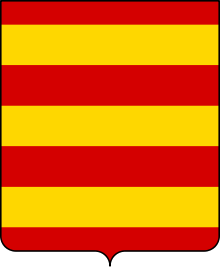Bonacolsi

The Bonacolsi were a noble family of Mantua who ruled Mantua in the last quarter of the 13th century and the first quarter of the 14th.
Pinamonte Bonacolsi was appointed one of two rectors of the commune on 12 July 1272, at first for a period of two months, internal strife among the extended kinship groups of the commune having reached excessive violence and murder. Within a few months Pinamonte was able to accuse and exile his co-rector Federico da Marcaria and the podestà, and gather power into his own hands. A communal reform in 1274 gave him a new position, capitano del popolo, which Pinamonte soon assumed for life.[1] Pinamonte pacified the city by exiling the most troublesome of the families, confiscating their goods, made peace among his neighbors, declared allegiance to the distant Emperor as a Ghibelline city; Mantua entered on a prosperious period.
His son Bardellone staged a successful coup that essentially unseated Pinamonte, on 29 September 1291; he was co-governor with his father, of whom nothing further is heard, however: Pinamonte died officially unnoticed, 7 October 1293. Bardellone's brother Tagino was exiled to Ferrara, where he formed lasting ties with the Este. Bardellone replaced the commune's consiglio maggiore with a consiglio del signore, 2 July 1294.[2]
Tagino's pardon and return from Ferrara in 1298 began a shift in Mantuan alliance from Verona to the Este in Ferrara, cemented by accords signed in Ferrara, 24 June 1299. Alberto I della Scala, lord of Verona, who favoured his own Bonacolsi, Bardellone's nephew Guido, took immediate action; he entered Mantua at the head of a troop and deposed and exiled Bardellone and Tagino in favour of Guido, who married Alberto's recently widowed daughter Costanza at the beginning of September.
The statute of 1303, that made Guido Bonacolsi captain-general of the city and comune of Mantua gave him unlimited powers, combining the executive, legislative, fiscal and judiciary, to "impose bans, absolve and convict... make war, enter truces, concords and peace, acquire friends, contract alliances, receive and rehabilitate exiles,appoint, install, dismiss, acquit and convict the podestà, rectors, judges, assessors, and all other officials and administrators, grant or remove their salaries,, convene councils and assemblies such that no councils, assemblies or meetings may be held without his special license..."[3] Guido died 24 January 1309, and was succeeded by his brother Rinaldo "Passerino", who had been an ally of Cangrande I della Scala.
On 16 August 1328, Rinaldo, the last Bonacolsi, was overthrown in a revolt backed by the Gonzaga, who seized power. Palazzo Bonacolsi (now Palazzo Castiglioni) that stands in piazza Sordello was commenced by Guido Bonacolsi as the Palazzo del Capitano. It was continuied as the Palazzo Ducale by the Gonzaga.
A lesser member of the clan, the sculptor Pier Jacopo Alari Bonacolsi (c. 1460–1528), was nicknamed "L'Antico" by his contemporaries for his refined interpretation of the Antique.